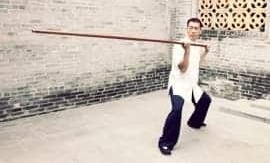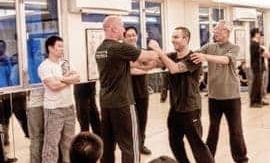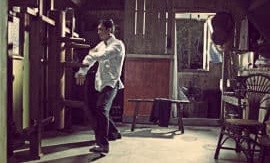
LEO IMAMURA (MOY YAT SANG) IS A DISCIPLE OF GRANDMASTER MOY YAT. THE “GUNG FU LIFE” PROCESS PROVIDED BY HIS SIFU MADE IT POSSIBLE FOR IMAMURA TO ACT IN DIFFERENT PROFESSIONAL AREAS, RANGING FROM PREPARING THE MILITARY FOR THE UN PEACEKEEPERS TO CONSULTING IN HUMAN RESOURCES MANAGEMENT FOR COMPANIES OF ALL SIZES.
As a full-time professional Sifu, he is dedicated to providing “Gung Fu Life” to his local and international Wing Chun descendants who come from Argentina, Brazil, Canada, China, Portugal, Spain, Switzerland, United States, as well as other countries.
In 1992, Imamura was the first university professor of martial arts recognised by the Education and Culture Ministry of Brazil and has been involved in a number of projects concerning the martial arts, particularly Wing Chun, for leading universities in his country.
Tell a bit about yourself and your training history. Where did you first get introduced to the term “Gung Fu Life”?
As a Brazilian-born Japanese, I began my journey through the study of Japanese martial arts in 1971. Eight years later, I became interested in Wing Chun. Master Lee Hon Kay was my first Sifu. Thanks to him, I was able to go to Hong Kong to deepen my studies. It was during that trip that I met Grandmaster Moy Yat in New York. In 1987, with Master Lee’s support, I was accepted into the Moy Yat Family. Grandmaster Moy Yat’s first words made the way he taught the system very clear: “In this family, you will learn Gung Fu and not Gung Fu techniques.”
Since the beginning, I was progressively introduced to “Gung Fu Life” by Grandmaster Moy Yat. Curiously, he used to advise me to train less—this was really a shock to me! Instead, he asked me to do small things, from making tea to playing the lottery. For that reason, “Gung Fu Life” was very frustrating to me in the beginning.
What is “Gung Fu Life”? how is it commonly misinterpreted?
It is important to emphasise that the term “Gung Fu Life” was coined by Grandmaster Moy Yat only to describe a traditional transmission process that he received from Patriarch Ip Man. One day, I asked Grandmaster Moy Yat about the corresponding term for “Gung Fu Life” in Chinese. He wrote the answer on a napkin for me: Sam Faat 心法. Sam Faat is a transmission process from the Confucian tradition, where learning is done intuitively through the experience of everyday activities. In this process, it is important to have a convivial relationship with a person that sees life through what can be called a “Gung Fu Perspective”. On the other hand, many people think they are experiencing “Gung Fu Life” only because they have a convivial relationship with a Gung Fu master by carrying his things and picking up their checks. Those are mere procedures. Sometimes, it is good to treat one’s Sifu to lunch, but other times it is not. Evaluating the situation in the here and now and knowing how to respond to it appropriately shows the capacity of a good Gung Fu practitioner.
Why did Grandmaster Moy Yat choose the term “Gung Fu Life” to represent Sam Faat?
When Grandmaster Moy Yat arrived in the USA in 1973, he saw that people learned martial arts in a very different way than the one he learned from Patriarch Ip Man. What he had learned with his Sifu was a Gung Fu for life. That is why he chose the term “Gung Fu Life”. My Sifu used to say that “Gung Fu Life” is a life that has Gung Fu inserted in it. To experience a life like that you must spend time with someone who is living within what some scholars call “Gung Fu Dimension” for enough time so that your life may be lived in this dimension. For him, Patriarch Ip Man was the greatest example of this type of person. Everything that he did was seen through a “Gung Fu Perspective”.
How did “Gung Fu Life” contribute to your development?
During the 14 years, I had a convivial relationship with Grandmaster Moy Yat—I had the unique experience of living physically with him 24/7. There were also moments when I had to go to Brazil and live from recollections of my experiences with my Gung Fu family in the USA. Every time I would return to the USA, Sifu would say, “Welcome home.” To him, my home was there. Once, he said to me, “Do you know why you must respect me as your Sifu? Because when you come back here from Brazil, I don’t change my routine to receive you. A regular Sifu, maybe they would take time off to receive you, but not Moy Yat. I allow you to enter my life exactly the way it is.” Thanks to the diligence of my Sifu, I have been able to live my life more intelligently and, to face the limitations of an average disciple like myself.
If you could go back and talk to your younger self, what advice would you give?
Pay more attention to the subtle aspects of a tendency. Some call it “Significant Evidence”. To do this, it’s important to remain relaxed. Many times, Grandmaster Moy Yat would stress a sense of urgency for a task and I would forget to evaluate what the best way to handle it would be. I wanted to do it immediately in order to comply with him, but I didn’t even know what was important for that situation. On the other hand, being too concerned with what my Sifu was thinking of me and what judgments were being made. For this reason, my suggestion to younger Leo would be “relax more” and “enjoy more” your “Gung Fu Life”. Don’t trouble yourself with how others will judge you—only focus your attention on the way that they are and how you can adjust to each person around you.
How does having good “Gung Fu Life” translate into developing good Wing Chun skill?
What people call “skill” is the visible part of Gung Fu, but it can only be expressed through an invisible process, which depends on both perception and feeling. This invisible dimension of Gung Fu is connected to Sam Faat. The greatest challenge of the martial artist is to defeat himself. Through human relationships, we can develop our own perceptions through the exterior world. Grandmaster Moy Yat used to compare a person that only learned Wing Chun techniques and another that had a convivial relationship with his/her Sifu and learned the Wing Chun system through “Gung Fu Life”. To him, the person that only came to learn techniques would never fulfil his/her intent because he/she would not know how to best use them when needed. On the other hand, for a person that would spend time and learn the system through “Gung Fu Life”, his/her Gung Fu would come from within, ready to be used should it be required.
Is it more difficult to live “Gung Fu Life” these days compared to in the past?
Modern life dynamics requires what we call “Scheduled Moments”. We have a time for everything, even to have fun. However, “Gung Fu Life” values the “Appropriate Moment,” in other words, the Sifu waits for the moment where the disciple is prepared to learn. It’s so natural that one might not notice this learning taking place. Currently, it is rare to find a master that is a “full-time” professional and is available for the disciple’s learning. In contrast, it’s uncommon to have disciples that have available time for this kind of learning. This is why we can say that it’s ever more seldom for us to develop relationships that privilege “Gung Fu Life”.
In March of 2000, Grandmaster Moy Yat called us for a meeting. During the meeting, our Sifu warned us about the importance of Sam Faat and also said that it would not be fair for the next generation to receive our legacy without this process of transmission. After all, he had dedicated so much to provide “Gung Fu Life” to us and also stated that this commitment should characterise his lineage, one generation after the other. Today, it’s identified as the Moy Yat Wing Chun Designation.
How has your understanding of “Gung Fu Life” changed over the years?
My understanding of the changes in “Gung Fu Life” through the years has a relationship with my last private conversation I had with Grandmaster Moy Yat, who noticed that this process was already changing. For him, it was important to create a set of tools that would make the “Gung Fu Life” commitment to his descendants viable. He believed it was important to develop a device that could fit the new challenges. “Without the creation of this set of tools, it’s possible that Wing Chun will not survive the next century,” he said that day. Since Grandmaster Moy Yat passed away, his main disciples have been dedicated to maintaining his legacy. I would like to name a few of my well-known Sihings such as Sunny Tang (Canada), Micky Chan (Hong Kong), Henry Moy, Lee Moy Shan, Pete Pajil, and Miguel Hernández (USA) who are reorganising the International Moy Yat Wing Chun Federation to help our leader Helen Moy and their son William Moy, with the purpose of supporting every descendant of Grandmaster Moy Yat to evolve his legacy—to provide “Gung Fu Life” as a way to access the Wing Chun system.



















